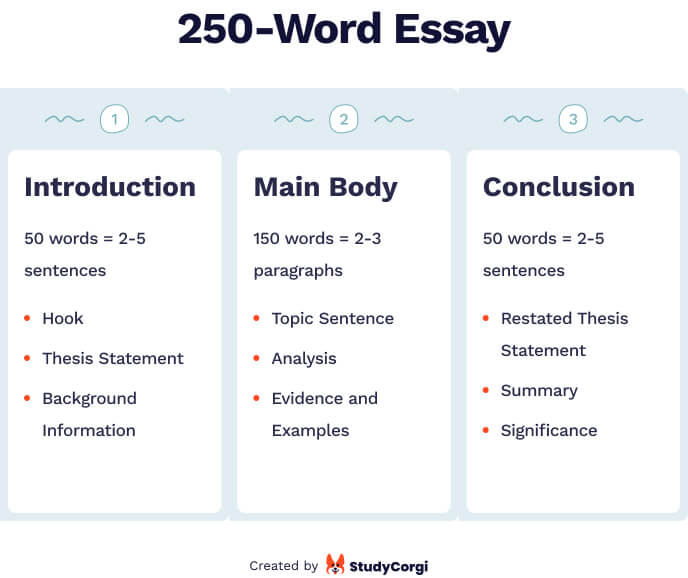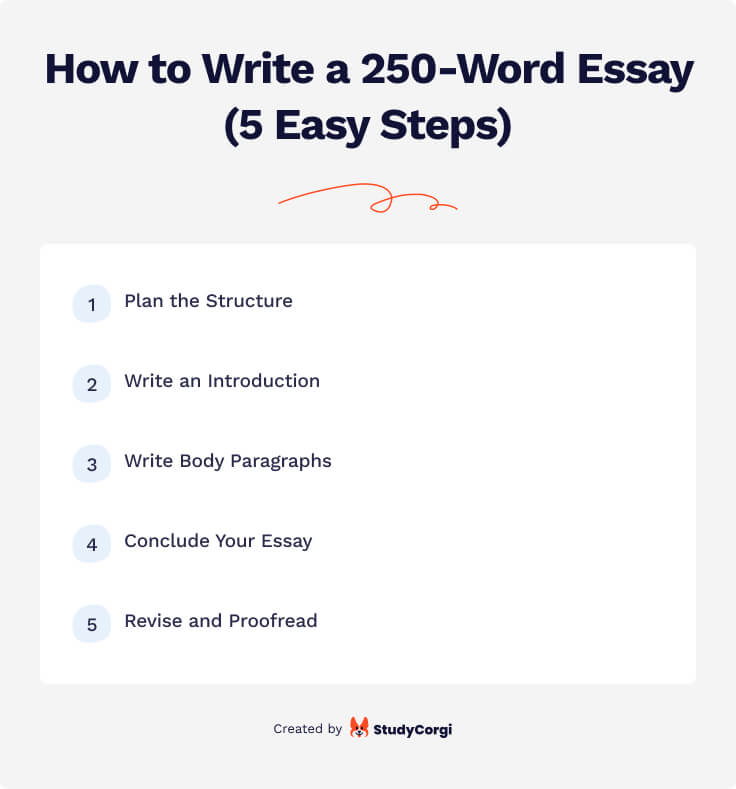A 250-word essay is a frequent task assigned to high school and college students. It’s a widely used format for scholarship applications and college admissions. However, mastering the art of concise yet impactful writing can challenge many students. If you feel overwhelmed by the task of condensing your ideas into 250 words—don’t worry; we have your back!
In this article, we’ll discuss the essential aspects of structuring and formatting a 250-word essay and provide examples. Prepare to discover the secrets that captivate and leave your readers in awe.
📝 What Does a 250-Word Essay Look Like
Most of the time, the challenge of beginning a 250-word essay stems from a lack of clarity on its structure and format. In this section, you’ll find outlines for various types of 250-word essays, highlighting their key components. With this valuable roadmap, you’ll be well-equipped to embark on your writing journey.

250 Word Essay Outline
A 250-word essay is a concise piece of writing that captures the essence of a topic within a restricted word count. It usually consists of an introduction, body paragraphs, and a conclusion. Each section plays a crucial role in shaping the essay’s overall length, making every word count.
- Introduction (about 50 words or 2-5 sentences). It should introduce the main idea, include a thesis statement, and catch the reader’s attention.
- Body (about 150 words for 2-3 paragraphs). The body should present your main points or arguments and provide evidence or examples.
- Conclusion (about 50 words). This part should summarize the main points discussed in the essay and include a rephrased thesis statement.
Now, let’s look at general outlines for different essay types.
Definition Essay
A definition essay explains the meaning of a specific term or concept. Usually, definition essay topics include questions like “Define X” or “What is an X?”.
Below is a typical outline for a 250-word definition essay.
Analytical Essay
An analytical essay answers questions like “Analyze X” or “What are the components of X?”. You may be required to analyze and interpret a piece of literature, artwork, or any other subject.
Here’s a typical outline for an analytical essay.
Cause & Effect Essay
A cause-and-effect essay explores the relationship between events or phenomena. Usually, it answers the questions like “What are the causes of X?” or “What led to X?”
The outline for a cause-and-effect essay looks as shown below.
Compare & Contrast Essay
A compare and contrast essay investigates the similarities and differences between two or more subjects. It aims to answer questions like “How does X differ from Y?” or “Compare X and Y.”
Check out the possible outline for a compare and contrast essay.
Process Essay
A process essay explains how to do something or how something works. It responds to prompts like “List the steps involved in X” or “Explain what happened in X.”
In a process essay, arranging your discussion in chronological order is a must. Here’s an example of an outline for this paper type.
Argumentative Essay
An argumentative essay presents a claim or argument on a controversial topic and supports it with evidence and reasoning. Usually, this kind of paper centers around a question like “A famous person said X. Do you agree or disagree?”
A typical outline for an argumentative essay looks as shown below.
250 Word Essay Format
Even though a 250-word essay is short, you should still format it according to the academic requirements. Here are the main ones:
- Font style. Avoid using fancy fonts, as they may be difficult to read. Instead, opt for standard fonts used in academic writing—Times New Roman or Arial. The default font provided by MS Word, Calibri, is also perfectly acceptable.
- Font size. It should be 11 or 12 points.
- Margins. Set margins to 1 inch (2.54 cm) on all sides.
- Line spacing. As a rule, professors expect papers to be double-spaced.
- Alignment. Your essay should be left-aligned: it looks neater than fully justified.
- Indents. Don’t indent the first line of your paragraphs.
250 Word Essay Length

A 250-word essay is approximately 1 double-spaced or 0.5 single-spaced pages. However, the essay’s length can vary depending on the margins, font size, and spacing. If you’re unsure about your paper’s formatting requirements, it’s better to consult your professor.
✅ How to Write a 250-Word Essay
At first, writing a 250-word essay may seem challenging, but following these steps can help you effectively organize your thoughts and create a concise and compelling paper.

1. Plan the Structure
Read and analyze the essay prompt or question carefully. Identify the central theme or idea you need to address in your essay. Then create an outline—it’s an essential step when writing such a concise paper. Decide on the main points you want to discuss and the order in which you will present them
2. Write the Introduction
Start with a hook that captures readers’ attention and then briefly review the topic and its significance. Introduce the key terms or concepts you will be discussing in your essay. Finally, develop a thesis statement—a sentence that contains the main idea of your writing.
3. Write the Body
Develop your main points in separate paragraphs. It’s best to start each with a topic sentence that expresses the paragraph’s main idea. Use evidence, examples, or research data to support your points. If you refer to any sources in your body paragraphs, remember to cite them properly to avoid plagiarism.
4. Conclude Your Essay
Summarize all the main points and emphasize the importance of your topic. Remind the readers of the thesis statement by paraphrasing it in the concluding paragraph. You can end your essay with a thought-provoking message, a call to action, or a suggestion for further research or exploration.
5. Revise and Proofread
Review your essay for clarity, coherence, and grammar errors. Ensure your ideas are well-organized and your writing is concise and to the point. Check for any repetitive or unnecessary information and remove it. Make sure your essay adheres to the formatting guidelines provided by your teacher.
🌟 250 Word Scholarship Essay: Writing Prompts
A 250-word writing is a standard format for scholarship and college application essays. For your inspiration, we collected some 250-word essay scholarship examples that you can check out below!
📃 250-Word Essay on Why I Deserve a Scholarship
In a 250-word essay on why you deserve a scholarship, you can focus on highlighting your achievements, goals, and aspirations that make you a deserving candidate for financial support. Here are some points you can include in the body paragraph:
- Academic achievements. Discuss your academic performance, including honors, awards, or other achievements.
- Personal accomplishments. Share any personal achievements that demonstrate your character, leadership skills, or commitment to making a positive impact.
- Future impact. Explain how the scholarship will enable you to contribute to society through research, innovation, community service, or other means.
📃 Why This College Essay: 250 Words Examples
In a “Why this college” essay, you explain why you are interested in attending a particular college or university. There are many points you can include in the body of your 250-word essay:
- Academic fit. Discuss how the college’s educational programs, majors, or courses align with your academic interests and goals.
- Campus culture and community. Explain why the college’s campus culture and student organizations resonate with you.
- Personal connection. Recount your own experiences or interactions with the college or its community. It may involve visiting the campus, participating in events, or engaging with current students or alumni.
📃 250 Word Essay on Why I Want to Be a Nurse
In a 250-word essay explaining your career choice, you should be authentic and sincere. Share personal experiences or realizations demonstrating your passion for a particular field. Here are some ideas you can use for a “Why I want to be a nurse” essay:
- Personal experiences. Discuss any personal experiences that have influenced your desire to become a nurse.
- Compassion and empathy. Highlight your natural inclination toward caring for others and your ability to empathize with those in need.
- Interest in healthcare. Share your interest in healthcare and how nursing aligns with your passion for promoting health and well-being.
📃 Life Changing Experience Essay: 250 Words
In a 250-word “life-changing experience” essay, you can focus on describing an event or series of events that impacted your life and changed your perspective, values, or goals. Here are some points you can include:
- Introduction. Introduce the event or experience you will discuss and explain its significance.
- Description. Describe the event or experience, focusing on your emotions and thoughts.
- Lessons learned. Share the lessons or insights you gained from the experience. What did you learn about yourself, others, or the world?
📖 Essay 250 Words: Example
If you’re still wondering how to write a concise but meaningful paper, check out our 250-word social media essay example.
The role of social media in spreading fake news and misinformation has become a significant concern in today’s digital age. With the increasing popularity of platforms like Facebook, Twitter, and Instagram, information can spread rapidly, regardless of its reliability and accuracy. This essay will explore how social media contributes to disseminating fake news and misinformation.
One of the primary reasons social media is a breeding ground for fake news is its ability to reach a vast audience within seconds. With minimal entry barriers, social platforms allow anyone to share information, regardless of its truthfulness, making it effortless for individuals with ill intentions to spread falsehoods among unsuspecting users.
Additionally, social media algorithms play a significant role in amplifying fake news. It prioritizes content that receives high levels of engagement, such as likes, shares, and comments. As a result, controversial content tends to receive more publicity, even if it lacks credibility.
In order to deal with the spread of false news on social media, platforms need to take accountability by enforcing stricter policies, implementing fact-checking measures, and prioritizing the promotion of reliable sources. It’s also essential to equip users with tools to authenticate information before sharing it to prevent the spread of misinformation on social media.
Social media undoubtfully plays a significant role in spreading false news and misinformation due to its expansive reach, algorithmic biases, and echo chamber effect. It is crucial for individuals to be critical consumers of information and for social media platforms to take proactive measures to combat this issue.
🤓 250 Words Essay Topics
A 250-word essay can cover various topics, depending on the assignment’s purpose and requirements. Here we’ve gathered some interesting ideas you can use for your paper:
- How does social media influence people’s self-esteem?
- Obesity and its effect on human health.
- Is animal testing ethical?
- Vaccines for kids: pros and cons.
- How does motivation affect people’s life and success?
- The social significance of wearing school uniforms.
- How safe is GMO food?
- The history of hip-hop music.
- The importance of promoting fair labor policies.
- Ways to prevent domestic violence.
- Various forms of dance and their cultural significance.
- The cultural importance of Renaissance art.
- How does the family environment affect students’ academic success?
- Homeschooling: pros and cons.
- How would you define success?
- Best ways to deal with stress.
- Should kindergartens be more literacy-based or play-based?
- How does pop culture affect teenagers?
- How do physical exercises influence mental health?
- The importance of family values.
❓250 Words Essay: FAQ
How Many Pages Is a 250-Word Essay?
The number of pages in a 250-word essay can vary depending on the font size, spacing, and formatting. A 250-word paper is approximately one double-spaced page or half a single-spaced page. It’s important to remember that the focus should be on the quality and content of the essay rather than the number of pages.
How Long is a 250-Word Essay?
The number of paragraphs and sentences in a 250-word essay can vary depending on the writer’s style. However, as a general guideline, a 250-word essay will likely consist of 3-4 paragraphs. The introduction and conclusion are usually the same length and comprise 1-2 sentences, while the body paragraphs make up the main content of the essay.
How to Write a 250-Word Essay for a Scholarship?
When writing a 250-word scholarship essay, you should take your time, be authentic, and ensure your paper reflects your true self. Start as soon as possible to have enough time before the application deadline. When brainstorming ideas, review other scholarship essay examples. Don’t hesitate to ask other people for feedback and help with proofreading.
